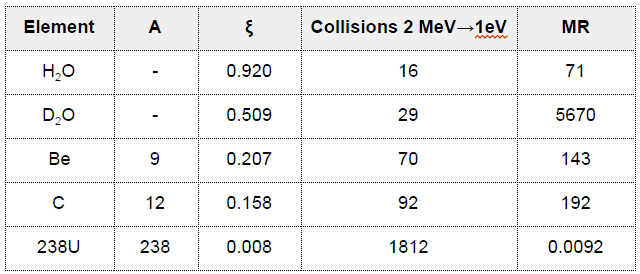Elastic Scattering and Neutron Moderators
To be an effective moderator, the probability of elastic reaction between neutron and the nucleus must be high. In terms of cross-sections, the elastic scattering cross-section of a moderator’s nucleus must be high. Therefore, a high elastic scattering cross-section is important but does not describe the comprehensive capabilities of moderators. To describe the capabilities of a material to slow down neutrons, three new material variables must be defined:
- high cross-section for neutron scattering
- high energy loss per collision
- low cross-section for absorption
- high melting and boiling point
- high thermal conductivity
- high specific heat capacity
- low viscosity
- low activity
- low corrosive
- cheap
Moderating Ratio – MR
The moderating ratio or moderator quality is the complete measure of a moderator’s effectiveness because it also takes into account the absorption effects. When absorption effects are high, the moderator will absorb most of the neutrons, leading to lower moderation or lower availability of thermal neutrons. Therefore a higher ratio of MSDP to absorption cross-sections ξ . Σs/Σa is desirable for effective moderation. This ratio is called the moderating ratio – MR and can be used as a criterion for comparing different moderators. Examples:
- Light water has the highest ξ and σs among the moderators (resulting in the highest MSDP) shown in the table. Still, its moderating ratio is low due to its relatively higher absorption cross-section.
- On the other hand, heavy water has lower ξ and σs, but it has the highest moderating ratio owing to its lowest neutron absorption cross-section.
- Graphite has much heavier nuclei than hydrogen in water. Even though graphite has much lower ξ and σs, it is a better moderator than light water due to its lower absorption cross-section than light water.
